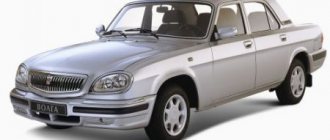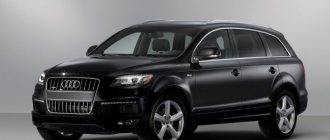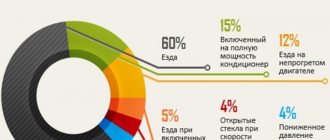The Chevrolet Lacetti first saw the light of day back in 2003. Released in South Korea, it replaced the Daewoo Nubira and, thanks to its excellent combination of price and quality, immediately showed a high sales rating. Stylish design, cheap maintenance, fuel consumption of the Chevrolet Lacetti - these and many other advantages have brought it to a leading position among other C-class cars. By the way, Italian designers did a good job on the exterior of the car, so even today it looks quite modern.
Chevrolet Lacetti engine modifications
This model is available in three body styles
:
- sedan;
- hatchback;
- station wagon;
| Engine | Consumption (city) | Consumption (highway) | Consumption (mixed cycle) |
| 1.4 Ecotec (petrol) 5-mech | 9.3 l/100 km | 5.9 l/100 km | 7.1 l/100 km |
| 1.6 Ecotec (petrol) 5-mech | 9 l/100 km | 6 l/100 km | 7 l/100 km |
| 1.8 Ecotec (petrol) 4-auto | 12 l/100 km | 7 l/100 km | 9 l/100 km |
| 2.0 D (diesel) 5-mech | 7.1 l/100 km | 4.8 l/100 km | 5.7 l/100 km |
The engines are available in three versions with manual and automatic transmission.
What is the gas consumption for Chevrolet Lacetti 1.6 AT+MT
The South Korean car's configuration with a 1.6-liter power unit under the hood implies a maximum speed of 187 km/h and engine power of 109 hp. The owners left the following reviews:
- Maxim, Kyiv. I am the owner of a Chevrolet Lacetti 1.6 with an automatic transmission. I can say one thing - the expense is high. On average, in the city it takes 15 liters, on the highway when traveling long distances along the highway - 7 liters. I don't know why there are so many. I contacted a specialized service several times from various specialists. Everyone shrugs. Maybe the car is new and hasn’t been broken in yet?
- Alexander, Kazan. I’m not a fan of driving fast, so I don’t give much gas in my car. With this approach, the consumption is 9 liters. I think this is within the normal range for a car with an automatic transmission.
- Igor, Voronezh. I don’t see much difference than refueling a Chevrolet Lacetti 1.6 with a manual transmission. I fill up with 92 and 95. Ideally, such an engine should consume 6.5-7 liters per 100 km during moderate driving. But I see slightly different numbers. In the city, even in traffic jams, consumption can reach 12 liters.
Modification 1.4 mt
This car is equipped with a 1.4 liter engine, the smallest volume of this line of cars. With a power of 94 horsepower, it reaches speeds of up to 175 km/h and is equipped with a five-speed manual transmission.
Fuel consumption on a Chevrolet Lacetti with a 1.4-liter engine capacity is the same for hatchback and sedan. It is 9.3 liters per 100 km for the urban cycle and 5.9 liters for the suburban cycle.
The most economical urban option pleases its owners not only with fuel consumption, but also with comfortable driving conditions.
Chevrolet Lacetti fuel consumption chart
Fuel consumption may vary depending on the vehicle modification. As well as the engine installed on it, the year of manufacture and other factors. All available information is structured in the form of tables below.
Generation 1
The first generation is designated J200 (sedan / sedan), (hatchback / hatchback), (wagon / station wagon), production years - 2004-2013.
| Chevrolet Lacetti Generation 1 | ||||||
| Modification | Average (l/100 km) | Route (l/100 km) | City (l/100 km) | Fuel type | Tank volume (liters) | |
| 1.4 l. i 16V, 95 hp | Manual transmission | 7.2 | 5.7 | 9.8 | Petrol | 60 |
| 1.6 l. i 16V, 109 hp | Manual transmission | 7.1 | 6.0 | 9.1 | ||
| Automatic transmission | 8.1 | 6.2 | 11.2 | |||
| 1.8 l. i 16V, 122 hp | Manual transmission | 7.5 | 6.2 | 9.8 | ||
| Automatic transmission | 9.1 | 6.9 | 12.5 | |||
Modification 1.6 mt
Fuel consumption on a Lacetti with a 1.6-liter engine depends on the body type. Engines of this volume are equipped with an injector and were produced until 2010. Such sedans and hatchbacks reached speeds of up to 187 km/h with a maximum power of 109 horsepower. The car was produced with a five-speed manual transmission.
The average fuel consumption of the Lacetti Hatchback in the city is 9.1 liters per 100 km,
the same figure for the sedan. But the station wagon already produces 10.2 liters in the same urban cycle.
Average consumption rates
Based on reviews from a large army of Lacetti owners, we can say that actual fuel consumption depends significantly on the cycle in which the car is operated. If in the city it takes from 8.5 to 13 liters per 100 km, then on the highway this value will be significantly lower - somewhere around 7–8.5 liters. However, if you decide to carry out such measurements yourself, then you need to fill the car with gasoline until the tank is full. The flow sensor will not help to tell you absolutely exactly what fuel consumption is for this Chevrolet model, since the error can be quite large.
Again, a lot depends on what style you prefer to drive. Aggressive drivers may notice that 12 liters in city mode is quite common. However, what if this figure is still higher? It will be necessary to carry out a full diagnosis, since it is quite possible that there are some malfunctions in the operation of the motor.
Real consumption and ways to save fuel
Factory figures are impressive, but is the real fuel consumption of the Chevrolet Lacetti per 100 km?
This value depends on many factors. Drivers cannot influence such factors as city traffic jams, air temperature in winter, and road conditions. But there are ways in which a car’s gasoline consumption can be significantly reduced:
- Driving style
. One of the main factors influencing consumption is experience and driving skills. This is confirmed by reviews that fuel consumption on a Chevrolet Lacetti (automatic) is slightly higher than on a car of the same power, but with a manual transmission, where engine speed is controlled by an experienced driver. - It is better to refuel your car at the same proven place, because the lower the quality of gasoline, the higher its consumption.
- Low tire pressure increases fuel consumption by more than 3%, so it is important to check the condition of the wheels as often as possible and regularly inflate them.
- Movement speed. Mercedes-Benz engineers calculated the aerodynamic properties of cars and came to the conclusion that when driving at speeds over 80 km/h, fuel consumption increases sharply
. - The air conditioner and heater have a significant effect on the consumption rate. To save fuel, you should not turn on these devices unnecessarily, but it is important to remember that open windows create increased air resistance and lead to high consumption.
- Excess weight
. You should not carry unnecessary things in the trunk for a long time, which add weight to the car, since accelerating a heavy body requires more fuel. Gasoline consumption on a Chevrolet Lacetti station wagon will increase by 10-15% with a tightly packed trunk. - Also, regular visits to a service station will help keep your car in good condition and prevent unnecessary waste of fuel. This will help you appreciate the unique Chevrolet Lacetti in its class, combining beauty, efficiency and high quality.
Chevrolet Lacetti fuel consumption 1.4, 1.6, 1.8 fuel consumption per 100 km
By kanistra Posted on 13/08/2015
In 2004, the South Korean company GM Daewoo began production of the Chevrolet Lacetti, which replaced the Daewoo Nubira. Initially it was released as a sedan, later a hatchback and a station wagon appeared. After 11 years, the model was discontinued and replaced by the Daewoo Gentra.
- 2.1 Owners about fuel consumption
- 3.1 Reviews on gasoline consumption
Chevrolet Lacetti 1.4 MT
Technical data
Chevrolet Lacetti was produced with gasoline power units, one of which has a displacement of 1.4 liters. The engine power is 95 hp, and the maximum speed of the car is 175 km/h. Consumption is 9.8 liters in the city and 5.7 liters on the highway.
Real consumption
- Anton, Ivanovo. Chevrolet Lacetti 1.4 MT 2012. I bought the car new. I think it's worth the money. Over the three years of operation, I only replaced the CV joint seal under warranty - it leaked in the winter, as well as the fuel tank sensor. There were no more problems. Consumption is quite acceptable - 10 liters in the city, 7 liters on the highway. The disadvantage is the low ground clearance; in winter, in snow and slush, the car sometimes gets stuck.
- Kirill, Moscow. I picked up the car in good condition (built in 2012). It turned out to be very reliable. Starts without problems, even in winter. Due to the quality of our roads, we had to change the rear strut stabilizers. The salon is spacious. The downside is that the engine is very weak for such a car, it doesn’t always work. Hence the high consumption - my Lacetti consumes 12 liters per hundred in the city and 8 liters on the highway.
- Ilya, Kaluga. When I bought it, the mileage was 88 thousand km. Now I have already driven 15 thousand km. The car was produced in 2007, quite unpretentious with inexpensive and simple maintenance. Despite its price, the interior is quite large and comfortable. There is too little power in the engine, it accelerates very slowly. It consumes 11-12 liters in the city and 7 liters on the highway. Poor visibility due to wide pillars.
- Leonid, Anapa. Chevrolet Lacetti 1.4 MT 2011. The car is used daily, as I work in a taxi service. Over the entire period, 230 thousand km have been accumulated. It earned its value within the first year and never let me down. I change the oil every 10 thousand km. At 50 thousand km the explosive wires were covered. Well, overall I’m happy with everything about it. The only thing is that its consumption would be lower: in the summer in the city it’s 9-9.5 liters, in the winter up to 12 liters. On the highway it's about 8.5 liters.
- Sergey, Tver. A very good and reliable car. For a family of four, this is a completely normal and inexpensive option. Stable on the highway. Despite the small dimensions, the interior turned out to be quite roomy. In all this time I have only changed the wheel bearings in my Chevrolet. Consumes about 8 liters of gasoline on average. Build 2005.
Chevrolet Lacetti 1.6 AT+MT
Information from the manufacturer
Another Chevrolet Lacetti petrol engine has a displacement of 1.6 liters. Its power is 109 hp, and the maximum speed is 187 km/h with acceleration to 100 in 11.4 s. Fuel consumption in the urban cycle is 10.3 liters, on the highway – 6.3 liters.
Other cars: Renault Kengo fuel consumption 1.4, 1.5, 1.9 diesel
Owners about fuel consumption
- Oleg, Moscow. Chevrolet Lacetti 1.6 AT 2008. The car has no competitors in this price category. Very reliable and spacious. The consumption is, of course, high, but the car also weighs quite a lot - almost one and a half tons. Per hundred, 12 liters are spent in the city and 7 liters on the highway. At 90 thousand km I replaced the front struts, there is also a problem with the glass freezing in winter. Very poor airflow.
- Igor, Chelyabinsk. The Lacetti is reminiscent of a Zhiguli in its simplicity. A very unpretentious car, but at the same time very reliable. The salon is large and comfortable. It behaves excellently on the highway, the consumption of the 1.6-liter is very high. If you try to save, then 8 liters will be difficult. And so confidently and consistently 10 liters per 100 km. Although many people say that they get 6 liters, I still can’t believe it.
- Alexander, Irkutsk. Before that I drove a Lanos. I took the Lacetti (2011 edition) only because I liked the price. A very big plus is the huge interior and trunk. The consumption of the 1.6-liter engine is also satisfactory: on average, 9 liters are consumed per hundred of the 92nd. I don't really like the appearance of the front bumper. Light bulbs often burn out. Low ground clearance for our roads.
- Pavel, Astrakhan. The car is designed for a large family. The trunk is quite roomy. The interior is much more comfortable when compared with Lada and Daewoo. Consumption is high, especially when driving around the city. Per 100 km up to 13 liters, and on the highway no more than 7.5 liters. It picks up speed very slowly, but then it goes fine. It's a bit difficult when overtaking. Model 2012 with automatic transmission.
- Vladimir, Naberezhnye Chelny. The car is excellent in terms of price/quality ratio. I've been driving it for more than 7 years (I bought a new one in 2007). Until now I have never charged or changed the battery. The standard tires wore out somewhere around 60 thousand km. Fuel consumption on the 1.6 MT engine is 11 liters city and 7.5 liters highway. A squeaking noise appears when changing gears. After I poured oil into the box, nothing changed.
Chevrolet Lacetti 1.8 AT+MT
Fuel consumption rate per 100 km
In addition to the 1.4 and 1.6-liter engines, there is a 1.8-liter gasoline engine under the hood. The power it can develop is 122 hp. This allows you to accelerate to a maximum of 194 km/h. In this case, the consumption will be 9.8 liters in the city and 6.2 liters on the highway.
Other cars: Gazelle Next 2.7, 2.8 fuel consumption diesel, gasoline and gas per 100 km.
Reviews about gasoline consumption
- Dmitry, Moscow. I chose a car from many options, but in the end I settled on the Lacetti. Since I took it by hand, I had to immediately change the oil and brake pads. Over time, when switching to reverse gear, a knock appeared and the check light began to light up. Consumption per hundred on average is about 8.5 liters.
- Eduard, Petersburg. A good purchase, over the course of 100,000 km I only changed consumables, shock absorbers and strut stabilizers. Spare parts for the Lacetti are relatively cheap. On the track the car behaves perfectly. The interior is large and comfortable, but the trunk is a bit small. The 1.8 engine is quite enough. Consumption is approximately 10.5 liters in the city. On the highway, 7 liters fit easily. If anyone is thinking about buying, I recommend it. I took the assembly from 2007.
- Natalya, Voronezh. Chevrolet Lacetti 1.8 MT 2008 Cool workhorse. Of the ones I've owned, this is the most reliable. They accelerate perfectly on the highway, the controls are surprisingly comfortable, so the car does not move from side to side. The interior is spacious and the whole family fits comfortably. At first the consumption was 8 liters, now it has dropped to 7 liters. I don't like the low ground clearance. I changed the timing belt a couple of times. A lot of oil is consumed.
- Sergey, Kyiv. A Lacetti with many advantages, and even at such a price. Constantly helps out. I go anywhere with it. It copes well with snow in winter, despite the low landing. Consumption is within 10 liters in the city and 6.5 liters on the highway. The big minus is the service from the officials. After the parking sensors failed, they refused to replace it under warranty. Assembled in 2008 with a 1.8 engine and automatic transmission.
- Natalia. Omsk Chevrolet Lacetti 1.8 MT 2008. I really like the car. Good appearance, the interior is large enough and comfortable with good ergonomics. The steering wheel is adjustable in several planes - it is very convenient. On the highway it holds course perfectly. Gasoline consumption remains at 10.5-11 liters in the city in summer, and up to 13 liters in winter. On the highway at 100 km/h it comes out to 7.5 liters.
Bringing the Chevrolet Lacetti to Mind
. . Finally sat down to write an article. Where to begin? Let's go in order. I see on TV and on the Internet that many people’s consumption is 9-10 liters on the highway and 13 in the city. I wonder if it is winter, summer or general. As promised, my overall average consumption over 4 years has now dropped to 8.5 l/100 km. If you consider that out of the 12,000 km that I travel in 1 year - 10,000 are city and only 2,000 are highway, maybe less - then this is not bad. The on-board computer shows everything correctly. I set it up accurately from the very beginning and now I periodically check its readings. Let's understand about my consumption:
. . 1) From the very beginning I treated the engine, gearbox and power steering with the XADO additive. The quality of the additive was tested on my former cars. Then came the fakes. The last time I treated the engine was Suprotek. . 2) This car doesn't like the cold. Consumption is approaching winter levels already at 10 degrees outside. The car begins to save noticeably after 90 degrees, and the thermostat is set at 87 (for use in Africa). In the block where the DTOZh is set, the temperature is exactly 5 degrees lower, and the ECU receives a signal of only 82 degrees. And if you drive along the highway, the thermostat opens and closes, the temperature drops another 5 degrees and it turns out to be 77. I set the thermostat to 92 degrees and all readings are 5 degrees higher. And then with the first cold weather I already cover the car and the engine and the front grille. I try to keep the temperature above 90. If it goes higher, then at 97 the fan will turn on at low speed and drive it down to 92. You can’t even hear it. And don’t look at the temperature arrow, it’s either 80 or 105 in the same place, it didn’t heat up further. Officials responded that this was a design feature. By the way, this happens on many foreign cars. I recently took some measurements, you can see them on this page Engine Temperature Arrow . . 3) I turned off the EGR valve so the engine gets more oxygen. Better combustion of the fuel mixture occurs (more efficiency) Shut off the EGR valve . . 4) I cheat the engine temperature. Each manufacturer makes cars with a safety margin of 10 - 15 percent. Otherwise all services would be full. Some wiring got oxidized and that’s it - the car stopped. It is this reserve that needs to be reduced to zero on a working machine in order to achieve savings. I turn on the snag at 20 degrees while moving and it immediately turns out to be 43 and I don’t even feel it. There is only a feeling when starting from a stop that the car is a little short of fuel. After warming up, the difference is 3 degrees Coolant Temperature Sensor Lacetti. . . 5) I also deceive the temperature sensor of the air entering the engine. What - no, but also savings. Air sensor Lacetti . . . 6) For more accurate readings of the absolute pressure sensor, I moved its connection fitting closer to the cylinders. How to improve DBP . At the beginning I tried to blunt it a little with two resistances. One is in the power wire, and the other is in the signal wire. But we didn’t get much savings with working sensor, but we were timid to overtake. Or maybe he has already chosen the entire margin of safety. If you further deplete the fuel mixture, then the consumption, on the contrary, will increase, and the car will be dull. We need to find a middle ground. . . 7) I use LED bulbs for daytime running lights. How to make an LED bulb from a burnt-out bulb . I tried it, and they both take only 0.1 ampere. Let's count who is driving on low beam: 4 light bulbs of 5 watts each - 20 watts, two headlights of 55 watts - 110. It turns out 130 watts divided by 12 volts, we get 10.83 amperes. I'm not counting the lights on the dashboard yet. In general, my computer shows an increase in consumption by 8 percent, and if you turn on the distant one, then it’s all 16.
. . I have one more plus - the car is not parked on the street, but in a brick unheated garage. But still, in winter the temperature there is 10 degrees higher, and besides, my engine is covered, and the car does not have time to cool down overnight, 10 degrees more than in the garage. At 20 below zero, the engine temperature is 0. So I come, start the car, turn on the heater, wait a couple of minutes until +3 and drive out. While I’m closing the garage it’s already +15, I’ve driven 30 meters and the temperature is already +20, I turn on the blende and go ahead. How to reduce fuel consumption in winter. . . 9) And the biggest savings with our reliable, but power-hungry DBP sensor depend on driving style. The power of the 1.6 engine is not enough for our car, although, as they say, it has a short gearbox. I'll try to explain. If you switched to 4th gear in the city, pressed the gas to accelerate and are about to move 60 km/h, then when you reach this speed, the car seems to fall into a stupor. Due to lack of power, it cannot accelerate to the degree corresponding to pressing the gas pedal. At this time, the working mixture is re-enriched, and it goes, for example, 7 l/100 km. It turns out there is not much tension. And if you release the gas pedal a little, the load on the engine will decrease, the mixture will become leaner, and the readings will already be 5 l/100 km. Although the car itself was moving 60 km/h and will continue to move 60 km/h. On engines with a mass air flow sensor this is not as pronounced as in ours with a DBP. To understand better, try driving 60-70 km/h in 3rd gear. There is already enough power here, and you yourself will lower the gas pedal by intuition. Did you see in the video my readings from Moscow to Kostroma at 5.2 l/100 km? I drove like this all the way, the speed was no more than 100 km/h. From the hills to neutral. It was a record. I usually get 6.2 l/100 km. when you don't watch the oar. 03/31/2020 Wrote a more detailed article - what makes up the consumption per 100 km, starting from the morning warm-up. Where do the crazy numbers on the On-Board Computer come from, and how does consumption drop with each kilometer traveled? You can read and watch the video on the What Fuel Consumption page.
. I have one more plus - the car is not parked on the street, but in a brick unheated garage. But still, in winter the temperature there is 10 degrees higher, and besides, my engine is covered, and the car does not have time to cool down overnight, 10 degrees more than in the garage. At 20 below zero, the engine temperature is 0. So I come, start the car, turn on the heater, wait a couple of minutes until +3 and drive out. While I’m closing the garage it’s already +15, I’ve driven 30 meters and the temperature is already +20, I turn on the blende and go ahead. How to reduce fuel consumption in winter. . . 9) And the biggest savings with our reliable, but power-hungry DBP sensor depend on driving style. The power of the 1.6 engine is not enough for our car, although, as they say, it has a short gearbox. I'll try to explain. If you switched to 4th gear in the city, pressed the gas to accelerate and are about to move 60 km/h, then when you reach this speed, the car seems to fall into a stupor. Due to lack of power, it cannot accelerate to the degree corresponding to pressing the gas pedal. At this time, the working mixture is re-enriched, and it goes, for example, 7 l/100 km. It turns out there is not much tension. And if you release the gas pedal a little, the load on the engine will decrease, the mixture will become leaner, and the readings will already be 5 l/100 km. Although the car itself was moving 60 km/h and will continue to move 60 km/h. On engines with a mass air flow sensor this is not as pronounced as in ours with a DBP. To understand better, try driving 60-70 km/h in 3rd gear. There is already enough power here, and you yourself will lower the gas pedal by intuition. Did you see in the video my readings from Moscow to Kostroma at 5.2 l/100 km? I drove like this all the way, the speed was no more than 100 km/h. From the hills to neutral. It was a record. I usually get 6.2 l/100 km. when you don't watch the oar. 03/31/2020 Wrote a more detailed article - what makes up the consumption per 100 km, starting from the morning warm-up. Where do the crazy numbers on the On-Board Computer come from, and how does consumption drop with each kilometer traveled? You can read and watch the video on the What Fuel Consumption page.
. . I’m already tired, and you probably are too. Let's sum it up: You can't save a lot. A lot can only be stolen . And you can save a little from all systems of the car, as they say, a penny per penny. So watch the video:
You can watch a video with winter consumption: Lacetti consumption in winter.
Go to Main page










